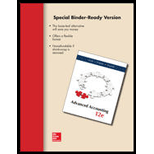
a.
Find the consolidated net income for Company P and its subsidiary.
a.
Explanation of Solution
Computation of consolidated net income for Company P and its subsidiary:
| Particulars | Amount |
| Net income of Company P | $ 300,000 |
| Net income of Company S | $ 110,000 |
| Unrealized profit of year 2014 | $ 7,200 |
| Unrealized profit of year 2015 | $ (16,200) |
| Excess amortization | $ (5,000) |
| Consolidated net income | $ 396,000 |
Table: (1)
b.
Find the consolidated net income to be allocated to the controlling and non-controlling interest if the intra-entity sales were upstream.
b.
Explanation of Solution
Computation of consolidated net income to be allocated to the controlling and non-controlling interest if the intra-entity sales were upstream:
| Particulars | Amount |
| Reported income of Subsidiary | $ 110,000 |
| Add: Unrealized gross profit of 2014 | $ 7,200 |
| Less: Unrealized gross profit of 2015 | $ (16,200) |
| Less: Excess amortization | $ (5,000) |
| Income to subsidiary to be consolidated | $ 96,000 |
| Percent of ownership of non-controlling interest | 20% |
| Net income attributable to non-controlling interest | $ 19,200 |
| Percent of ownership of controlling interest | 80% |
| Net income attributable to controlling interest | $ 76,800 |
Table: (2)
c.
Find the consolidated net income to be allocated to the controlling and non-controlling interest if the intra-entity sales were downstream.
c.
Explanation of Solution
Computation of consolidated net income to be allocated to the controlling and non-controlling interest if the intra-entity sales were downstream:
| Particulars | Amount |
| Reported income of Subsidiary | $ 110,000 |
| Less: Excess amortization | $ (5,000) |
| Income to subsidiary to be consolidated | $ 105,000 |
| Percent of ownership of non-controlling interest | 20% |
| Net income attributable to non-controlling interest | $ 21,000 |
| Percent of ownership of controlling interest | 80% |
| Net income attributable to controlling interest | $ 84,000 |
Table: (3)
d.
Find the consolidated balance in the ending Inventory account.
d.
Explanation of Solution
Computation of consolidated balance in the ending Inventory account:
| Particulars | Amount |
| Balance of Company P | $ 140,000 |
| Add: Balance of inventory of Company S | $ 90,000 |
| Add: Defer unrealized gross profit of 2015 | $ (16,200) |
| Consolidated balance of cost of goods sold | $ 213,800 |
Table: (4)
Thus, the consolidated total for inventory at December 31 is $213,800.
e.
Find the consolidate balance of land in 2015.
e.
Explanation of Solution
Computation of consolidated balance in the Land account:
| Particulars | Amount |
| Balance of Company P | $ 600,000 |
| Add: Balance of land of Company S | $ 200,000 |
| Add: Defer unrealized profit of 2015 | $ (20,000) |
| Consolidated balance of cost of goods sold | $ 780,000 |
Table: (5)
Thus, the consolidated total for land at December 31 is $780,000.
f.
Provide the worksheet entries to eliminate intra-entity transfer and find the non-controlling interest’s share of Company S’s net income.
f.
Explanation of Solution
The worksheet entries to eliminate intra-entity transfer:
| Entry TA | ||||
| Date | Accounts Title and Explanation | Post Ref. | Debit | Credit |
| Equipment | $ 20,000 | |||
| Investment in Company S | $ 16,000 | |||
| | $ 36,000 | |||
| (Being excess depreciation eliminated) | ||||
| Entry ED | ||||
| Date | Accounts Title and Explanation | Post Ref. | Debit | Credit |
| Accumulated Depreciation | $ 4,000 | |||
| Depreciation expense | $ 4,000 | |||
| (being excess depreciation eliminated) | ||||
Table: (6)
Computation of the non-controlling interest’s share of Company S’s net income:
| Particulars | Amount |
| Reported income of Subsidiary | $ 110,000 |
| Less: Excess amortization | $ (5,000) |
| Less: Gain on sale of equipment | $ (12,000) |
| Income to subsidiary to be consolidated | $ 93,000 |
| Percent of ownership of non-controlling interest | 20% |
| Net income attributable to non-controlling interest | $ 18,600 |
Table: (7)
Want to see more full solutions like this?
Chapter 5 Solutions
Advanced Accounting (Looseleaf)
- Which of the following is an intangible asset? A) InventoryB) CopyrightC) EquipmentD) Accounts Receivableno aiarrow_forwardWhich of the following is an intangible asset? A) InventoryB) CopyrightC) EquipmentD) Accounts Receivablearrow_forwardWhat does a ledger account represent? A) A detailed record of all business transactionsB) A summary of trial balancesC) An individual record for each accountD) The final balance of a financial statement Need help!arrow_forward
- What is the primary purpose of accounting? A) To generate tax revenueB) To record, summarize, and report financial transactionsC) To determine the market value of assetsD) To manage payrollarrow_forwardWhat are the three main financial statements in accounting?arrow_forwardCan you solve this general accounting question with accurate accounting calculations?arrow_forward

 AccountingAccountingISBN:9781337272094Author:WARREN, Carl S., Reeve, James M., Duchac, Jonathan E.Publisher:Cengage Learning,
AccountingAccountingISBN:9781337272094Author:WARREN, Carl S., Reeve, James M., Duchac, Jonathan E.Publisher:Cengage Learning, Accounting Information SystemsAccountingISBN:9781337619202Author:Hall, James A.Publisher:Cengage Learning,
Accounting Information SystemsAccountingISBN:9781337619202Author:Hall, James A.Publisher:Cengage Learning, Horngren's Cost Accounting: A Managerial Emphasis...AccountingISBN:9780134475585Author:Srikant M. Datar, Madhav V. RajanPublisher:PEARSON
Horngren's Cost Accounting: A Managerial Emphasis...AccountingISBN:9780134475585Author:Srikant M. Datar, Madhav V. RajanPublisher:PEARSON Intermediate AccountingAccountingISBN:9781259722660Author:J. David Spiceland, Mark W. Nelson, Wayne M ThomasPublisher:McGraw-Hill Education
Intermediate AccountingAccountingISBN:9781259722660Author:J. David Spiceland, Mark W. Nelson, Wayne M ThomasPublisher:McGraw-Hill Education Financial and Managerial AccountingAccountingISBN:9781259726705Author:John J Wild, Ken W. Shaw, Barbara Chiappetta Fundamental Accounting PrinciplesPublisher:McGraw-Hill Education
Financial and Managerial AccountingAccountingISBN:9781259726705Author:John J Wild, Ken W. Shaw, Barbara Chiappetta Fundamental Accounting PrinciplesPublisher:McGraw-Hill Education





